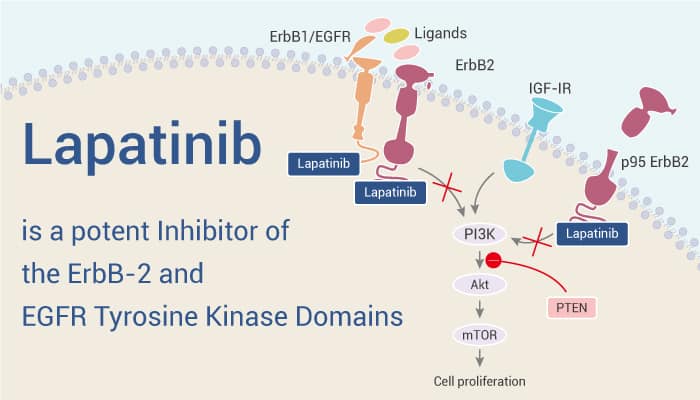Growth factors and their transmembrane receptor tyrosine kinase play important roles in cell proliferation, survival, migration, and differentiation. Additionally, Epidermal growth factor (EGF)-like proteins stimulates cells to divide by activating members of the EGF receptor (EGFR) family. Many types of human tumor cells growth and development are related to the EGFR signaling module. Therefore, modulating EGFR signal transduction has become an effective anticancer target.
Lapatinib is a reversible and specific tyrosine kinases receptor inhibitor of ErbB1 and ErbB2. Besides, it possesses high affinity with Kiapps of 3 nM and 13 nM for ErbB1 and ErbB2, respectively. According to kinds of research, this drug has high antiproliferative activity against HER2-positive breast cancer cells. As a result, it has antitumor activity in vivo.
Lapatinib Exhibits Potent Activity in vitro and in vivo.
 In cell experiments, Lapatinib inhibits the growth of HER-2-overexpressing BT474 cells at a low concentration (IC50 = 100 nM). It can also inhibit the proliferation of various human breast cancer cell lines in a concentration-dependent manner. The results of researches show that Lapatinib blocks breast cancer cells’ growth by inducing G1 arrest and inhibiting phosphorylation of serine 473 of AKT and increasing phosphorylation of tyrosine residues 180 and 182 of p38. In addition, it induces ferroptosis cell death in breast cancer cells.
In cell experiments, Lapatinib inhibits the growth of HER-2-overexpressing BT474 cells at a low concentration (IC50 = 100 nM). It can also inhibit the proliferation of various human breast cancer cell lines in a concentration-dependent manner. The results of researches show that Lapatinib blocks breast cancer cells’ growth by inducing G1 arrest and inhibiting phosphorylation of serine 473 of AKT and increasing phosphorylation of tyrosine residues 180 and 182 of p38. In addition, it induces ferroptosis cell death in breast cancer cells.
In the breast cancer mice model, Lapatinib (75 mg/kg, PO, twice daily for 77 days) significantly suppresses the growth of the tumor. Besides, Lapatinib (30 or 100 mg/kg; PO, twice daily for 24 days) also effectively inhibits metastatic colonization of mouse brain by 231-BR breast carcinoma cells.
In conclusion, Lapatinib is a potent tyrosine kinases receptor inhibitor of ErbB1 and ErbB2. It can be used for anti-breast cancer.
Reference
[1] Konecny GE, et al. Cancer Res. 2006;66(3):1630-1639.
[2] Gril B, et al. J Natl Cancer Inst. 2008;100(15):1092-1103.
[3] Ma S, et al. PLoS One. 2017;12(8):e0182921.